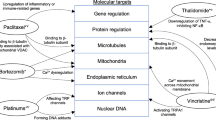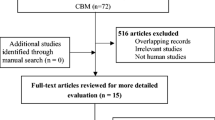Abstract
Background
Studies by our group demonstrated brain-derived neurotrophic factor (BDNF) levels in blood and BDNF-Val66met-SNP as potential biomarkers in chemotherapy-induced peripheral neuropathy. Here, we evaluate symptoms of peripheral neuropathy (PN) and depression in patients with type II diabetes mellitus in search of an association with serum BDNF levels and the Val66Met-SNP.
Methods
In total, 90 patients enrolled in the study; 23 (25.6%) had known PN, as determined by nerve conduction studies (NCS–PN), and 67 (74.4%) were not diagnosed with PN (U-PN). PN symptoms were assessed and graded in these groups using the total neuropathy score (TNSr) and DN4 scales. Small nerve fiber testing of sensitivity thresholds to cold, warm and hot pain signals was performed using the Q-sense device. Depression was assessed using the PHQ9 questionnaire. BDNF protein levels and Val66Met-SNP were determined with ELISA and Sanger sequencing, respectively.
Results
NCS–PN patients showed lower serum BDNF levels alongside significantly higher TNSr, DN4 and PHQ9 scores and lower hot pain sensitivity thresholds as compared to U-PN patients. Patients with Met-BDNF-SNP showed increased TNSr scores and lower hot pain sensitivity thresholds as compared to patients with Val-BDNF-SNP. Depression showed a weaker correlation with sensitivity thresholds to hot pain signals as compared to TNSr and DN4 scores.
Conclusions
Diminished peripheral BDNF resources and Met-BDNF-SNP genotype are associated with augmented symptoms of PN in patients with type II diabetes mellitus. Sensitivity thresholds to hot pain signals may be less influenced by depression and possibly more accurately detect PN symptoms in diabetic patients.



Similar content being viewed by others
References
Johnson JE, Barde YA, Schwab M, Thoenen H (1986) Brain-derived neurotrophic factor supports the survival of cultured rat retinal ganglion cells. J Neurosci 6(10):3031–3038
Yamamoto H, Gurney ME (1990) Human platelets contain brain-derived neurotrophic factor. J Neurosci 10(11):3469–3478
Fujimura H, Altar CA, Chen R et al (2002) Brain-derived neurotrophic factor is stored in human platelets and released by agonist stimulation. Thromb Haemostasis 87(4):728–734
Chacon-Fernandez P, Sauberli K, Colzani M, Moreau T, Ghevaert C, Barde YA (2016) Brain-derived neurotrophic factor in megakaryocytes. J Biol Chem 291(19):9872–9881
Kerschensteiner M, Gallmeier E, Behrens L et al (1999) Activated human T cells, B cells, and monocytes produce brain-derived neurotrophic factor in vitro and in inflammatory brain lesions: a neuroprotective role of inflammation? J Exp Med 189(5):865–870
Azoulay D, Urshansky N, Karni A (2008) Low and dysregulated BDNF secretion from immune cells of MS patients is related to reduced neuroprotection. J Neuroimmunol 195(1–2):186–193
Azoulay D, Vachapova V, Shihman B, Miler A, Karni A (2005) Lower brain-derived neurotrophic factor in serum of relapsing remitting MS: reversal by glatiramer acetate. J Neuroimmunol 167(1–2):215–218
Egan MF, Kojima M, Callicott JH et al (2003) The BDNF val66met polymorphism affects activity-dependent secretion of BDNF and human memory and hippocampal function. Cell 112(2):257–269
Bialecka M, Kurzawski M, Roszmann A et al (2014) BDNF G196A (Val66Met) polymorphism associated with cognitive impairment in Parkinson's disease. Neurosci Lett 561:86–90
Borroni B, Archetti S, Costanzi C et al (2009) Role of BDNF Val66Met functional polymorphism in Alzheimer's disease-related depression. Neurobiol Aging 30(9):1406–1412
Krabbe KS, Nielsen AR, Krogh-Madsen R et al (2007) Brain-derived neurotrophic factor (BDNF) and type 2 diabetes. Diabetologia 50(2):431–438
Fujinami A, Ohta K, Obayashi H et al (2008) Serum brain-derived neurotrophic factor in patients with type 2 diabetes mellitus: Relationship to glucose metabolism and biomarkers of insulin resistance. Clin Biochem 41(10–11):812–817
de la Monte SM (2017) Insulin resistance and neurodegeneration: progress towards the development of new therapeutics for Alzheimer's disease. Drugs 77(1):47–65
Seki M, Tanaka T, Nawa H et al (2004) Involvement of brain-derived neurotrophic factor in early retinal neuropathy of streptozotocin-induced diabetes in rats: therapeutic potential of brain-derived neurotrophic factor for dopaminergic amacrine cells. Diabetes 53(9):2412–2419
Andreassen CS, Jakobsen J, Flyvbjerg A, Andersen H (2009) Expression of neurotrophic factors in diabetic muscle–relation to neuropathy and muscle strength. Brain 132(10):2724–2733
Azoulay D, Leibovici A, Sharoni R et al (2015) Association between Met-BDNF allele and vulnerability to paclitaxel-induced peripheral neuropathy. Breast Cancer Res Treat 153(3):703–704
Azoulay D, Lavie D, Horowitz N et al (2014) Bortezomib-induced peripheral neuropathy is related to altered levels of brain-derived neurotrophic factor in the peripheral blood of patients with multiple myeloma. Br J Haematol 164(3):454–456
Azoulay D, Nasser R, Sharon R et al (2018) Brain derived neurotropic factor single nucleotide polymorphism Val66Met and serum protein levels are associated with development of vincristine-induced peripheral neuropathy in patients with lymphoma. Br J Haematol 185:175–177
Azoulay D, Giryes S, Nasser R, Sharon R, Horowitz NA (2019) Prediction of chemotherapy-induced peripheral neuropathy in patients with Lymphoma and Myeloma: the roles of brain-derived neurotropic factor protein levels and a gene polymorphism. J Clin Neurol 15(4):511–516
Leibovici A, Sharon R, Azoulay D (2018) BDNF Val66Met is associated with pre-existing but not with Paclitaxel-induced peripheral neuropathy in an Israeli cohort of breast cancer patients. Isr Med Assoc J IMAJ 20(12):746–748
Smith EM, Beck SL, Cohen J (2008) The total neuropathy score: a tool for measuring chemotherapy-induced peripheral neuropathy. Oncol Nurs Forum 35(1):96–102
Celik S, Yenidunya G, Temel E et al (2016) Utility of DN4 questionnaire in assessment of neuropathic pain and its clinical correlations in Turkish patients with diabetes mellitus. Prim Care Diabetes 10(4):259–264
Hovaguimian A, Gibbons CH (2011) Diagnosis and treatment of pain in small-fiber neuropathy. Curr Pain Headache Rep 15(3):193–200
Gilbody S, Richards D, Brealey S, Hewitt C (2007) Screening for depression in medical settings with the Patient Health Questionnaire (PHQ): a diagnostic meta-analysis. J Gen Intern Med 22(11):1596–1602
Perkins BA, Olaleye D, Zinman B, Bril V (2001) Simple screening tests for peripheral neuropathy in the diabetes clinic. Diabetes Care 24(2):250–256
Tracy JA, Dyck PJ (2008) The spectrum of diabetic neuropathies. Phys Med Rehabil Clin N Am 19(1):1–26
Bouhassira D, Letanoux M, Hartemann A (2013) Chronic pain with neuropathic characteristics in diabetic patients: a French cross-sectional study. PLOS ONE 8(9):e74195
Kramer HH, Rolke R, Bickel A, Birklein F (2004) Thermal thresholds predict painfulness of diabetic neuropathies. Diabetes Care 27(10):2386–2391
Lustman PJ, Clouse RE (2005) Depression in diabetic patients: the relationship between mood and glycemic control. J Diabetes Complic 19(2):113–122
Sharif S, Raza MT, Mushtaq S, Afreen B, Hashmi BA, Ali MH (2019) Frequency of depression in patients with type 2 diabetes mellitus and its relationship with glycemic control and diabetic microvascular complications. Cureus 11(7):e5145
Vileikyte L, Leventhal H, Gonzalez JS et al (2005) Diabetic peripheral neuropathy and depressive symptoms: the association revisited. Diabetes Care 28(10):2378–2383
Zaslansky R, Yarnitsky D (1998) Clinical applications of quantitative sensory testing (QST). J Neurol Sci 153(2):215–238
Shukla G, Bhatia M, Behari M (2005) Quantitative thermal sensory testing—value of testing for both cold and warm sensation detection in evaluation of small fiber neuropathy. Clin Neurol Neurosurg 107(6):486–490
Azoulay D, Nasser R, Sharon R et al (2019) Brain derived neurotropic factor single nucleotide polymorphism Val66Met and serum protein levels are associated with development of vincristine-induced peripheral neuropathy in patients with lymphoma. Br J Haematol 185(1):175–177
Pliego-Rivero FB, Bayatti N, Giannakoulopoulos X et al (1997) Brain-derived neurotrophic factor in human platelets. Biochem Pharmacol 54(1):207–209
Tamura S, Suzuki H, Hirowatari Y et al (2011) Release reaction of brain-derived neurotrophic factor (BDNF) through PAR1 activation and its two distinct pools in human platelets. Thromb Res 128(5):e55–e61
Azoulay D, Mausner-Fainberg K, Urshansky N, Fahoum F, Karni A (2009) Interferon-beta therapy up-regulates BDNF secretion from PBMCs of MS patients through a CD40-dependent mechanism. J Neuroimmunol 211(1–2):114–119
Karczewska-Kupczewska M, Kowalska I, Nikolajuk A et al (2012) Circulating brain-derived neurotrophic factor concentration is downregulated by intralipid/heparin infusion or high-fat meal in young healthy male subjects. Diabetes Care 35(2):358–362
Chen ZY, Bath K, McEwen B, Hempstead B, Lee F (2008) Impact of genetic variant BDNF (Val66Met) on brain structure and function. Novartis Found Symp 289:180–188
Acknowledgements
We wish to thank Rivka Sharon for designing PCR analysis of BDNF and the Israel Ministry of Galilee Development for their support of editing the final manuscript and preparing the layout. This work was supported by grant from D-cure.
Author information
Authors and Affiliations
Contributions
DA designed the study, performed experiments, analyzed the data, interpreted the data and wrote the manuscript. AS and SA recruited patients to the study and performed neurological assessment of PN symptoms and depression. OS performed PCR analysis for BDNF-SNP genotyping. MS performed vitamin B12 analysis in patients. ES, MN and EK helped design the study and interpret the data. Amir Bashkin advised the clinical aspects of the study, recruited patients to the study and interpret the data.
Corresponding author
Ethics declarations
Conflict of interest
The authors declare that they have no conflicts of interest.
Ethical approval
This study have been reviewed by the appropriate ethics committee and have therefore been performed in accordance with ethical standards laid down in appropriate version of the 1964 Declaration of Helsinki (Galilee Medical Center approval # 0061-15-NHR, April 2nd 2015).
Informed consent
All persons gave their informed consent prior to their inclusion in the study.
Additional information
Managed By Massimo Federici.
Publisher's Note
Springer Nature remains neutral with regard to jurisdictional claims in published maps and institutional affiliations.
Electronic supplementary material
Below is the link to the electronic supplementary material.
592_2020_1508_MOESM1_ESM.pptx
Figure 1: TNSr, DN4 and hot-pain sensitivity threshold in patients with depression. A. The graph presents the overall TNSr and DN4 scores of patients with minimal symptoms of depression (white bars) and patients with depression (black bars). Bars represent mean (± SEM) scores. *p value < 0.05. B. The bars show the mean (± SEM) hot-pain temperature thresholds of patients with minimal symptoms of depression and patients with depression. *p value < 0.05. (PPTX 46 kb)
Rights and permissions
About this article
Cite this article
Azoulay, D., Abed, S., Sfadi, A. et al. Low brain-derived neurotrophic factor protein levels and single-nucleotide polymorphism Val66Met are associated with peripheral neuropathy in type II diabetic patients. Acta Diabetol 57, 891–898 (2020). https://doi.org/10.1007/s00592-020-01508-6
Received:
Accepted:
Published:
Issue Date:
DOI: https://doi.org/10.1007/s00592-020-01508-6




